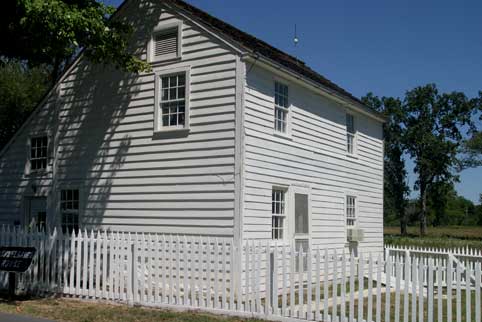Age
All Ages - Family Fun Event
Due to constant changes to location(s) hours, days and availability, please check the location website or contact via phone prior to planning a visit.
HISTORY & DESCRIPTION
The Civil War battle of Gettysburg was a 3 day fight; July 1st to July 3rd, 1863, in the countryside and farmland near the town of Gettysburg, covering 40 miles.
General Robert E. Lee was on his way to bring the war to the north, taking the pressure off Virginia, in areas where his soldiers could live off the land, perhaps forcing a settlement, letting the south become its own country.
According to legend, the confederate troops needed boots. Conveniently, Gettysburg was known for its tanning industry and its shoes. As it was on the way, General Robert E. Lee marched in and took over the town, to take boots for his troops. However, the Union Army caught up with them.
Another source said that the first stop for Lee was a small village, called Cashtown, a village located between Chambersburg and Gettysburg. After learning through a spy that the Union Troops, led by General George Meade were onto his plan to attack the north at Harrisburg, Lee sent a reconnaissance team to Gettysburg, while preparing to meet the Union troops in battle, when they were spotted. This confederate recognizance team inadvertently bumped into the Union recognizance team also sent to Gettysburg, which began the battle.
This incredibly bloody and costly battle killed 50,000 men, (almost as many killed in the 7 year war in Viet Nam). It was the turning point in the Civil War, giving the advantage to the Union forces.
Because of all the suffering, deaths and loss that go along with such a battle event, The Gettysburg National Military Park has many hauntings and entity sightings, even 142 years later. Many soldiers are still on duty, or experiencing the terrifying events leading to their deaths.
Other hauntings not related to the battle also have been reported in the National Park, because the land's history started long before 1863, and continues until the present.
MANIFESTATIONS:
Little Round Top — For the union troops, it was a strategic position, being up on a hilly slope, giving them a great view of the land below.
Location: This site can be found at the southernmost section of the park.
A headless horseman, probably an officer is still holding forth, riding his horse around, encouraging his troops. He was probably decapitated during hand to hand combat at some point, or perhaps was the unlucky recipient of a direct hit from a cannonball.
Phantom soldiers and apparitions are still seen marching in formation and riding horses in their fight against their enemy, which is true in many of the battle areas, including Pickett's Field, the Peach Orchard, the Wheat Field and the Triangular Field which is discussed below.
During the filming of the film, Gettysburg, actors/Civil War re-enactors dressed in uniform would often walk off set, exploring the real Battlefields during their down time. A group of Union soldiers went up to the Little Round Top area, to enjoy the lovely sunset. While standing there, they heard the rustling of leaves behind them. Looking to see who it was. Imagine their surprise when a "rather haggard looking old man, dressed as a Union private", made his appearance. "The man was filthy and smelled of sulfur, a key ingredient of the black powder used in 1863. He walked up to the men and as he handed them a few musket rounds. He said, 'Rough one today, eh boys?' He turned and walked away." As the startled men examined these musket rounds, this mystery man vanished into thin air. They brought these musket rounds into the town of Gettysburg, which were "authenticated as original rounds 130 years old"!
Devil's Den, and Areas around it.
This area can be found west of Little Round Top, in the Triangular Field, called the valley of death, as it became a "slaughter field." It is considered the most haunted spot in the Park. It is no wonder as not only are Phantom soldiers and apparitions often seen here, but Indian Warriors as well.
Devil's Den, besides being a hot spot in this battle, also was the scene years before of the huge Battle of the Crows. War Hoops and apparitions of dead warriors had been seen in this area years before this Civil War Battle. The creepiness and strangeness of this huge piling of boulders which create deep crevices and mazes already had an infamous reputation before the Union and Confederate troops used it as a position.
Devil's Den is a pile of rocks that long-haired confederate cavalrymen from Georgia and Texas fought fiercely for and finally drove the Union forces out, after suffering many casualties, as they fought their way across Triangular Field to Devil's Den. After the 3 day Battle of Gettysburg ended and the lucky ones who survived the fight for Devil's Den, retreated with Lee, the Union forces found the seemingly endless numbers of bodies in the valley and on the boulders. Many were not buried but thrown down the deep crevices of the rocks, as they were already rotting. The lucky ones were buried days/weeks later.
Visitors and Park Rangers have seen the apparitions of sharpshooters among the tree line of Triangular Field and have heard phantom sounds of gunshots and drum rolls coming from the wooded area of this field.
Because of all the energy still swirling in this valley, camera crews trying to film the valley found that their equipment wouldn't work at all.
After the battle, it is said that a callous photographer, Alexander Gardner, who was taking pictures of dead confederate soldiers, moved the dead body of a soldier and posed it to get a better shot for his newspaper. This didn't sit well with the scruffy-looking entities who still haunt the place, who died taking this position.
People taking pictures of Devil's Den have had trouble with their cameras getting jammed or even thrown to the ground by some incensed entity. If one explains out loud what one's intentions are, one can take pictures of Devil's Den.
One cameraman, whose homemade, wooden camera was physically knocked off its stand twice, eventually into a boulder cave, that the cameraman had to climb down into, to retrieve the camera. On the second trip to the same area, the camera man's teammate explained that the cameraman was from Texas, and wanted to use his pictures to honor what Texans had accomplished there. No more problems with the camera falling happened for this team of paranormal investigators.
During our summer of 2006 visit, Tom and I visited the battleground areas. In the Devils Den area, one can walk up a path which winds around the rocks and eventually brings the visitor to the top ridge. About half way up the path, in the middle of the Devil's Den, weird occurrences began to occur. While I was trying to take pictures of the huge rocks about halfway up the path, and the triangle field, something kept pushing the button on my digital camera to turn it off, trying to stop me from taking pictures. b) If the entities are in a good mood and like you, they may even pose in your picture individually or as a group, which you won't see until the film is developed. A man who had his film developed, saw this man which he described as a hippie, standing in his picture!
While standing near Devil's Den, A female visitor near Devil's Den was trying to get a photograph in the early morning light. She felt someone come up behind her. She turned around and saw a lifelike apparition of a Texas soldier standing there, described as scruffy-looking hippie type with ragged clothing, a shirt without buttons, a big hat and no shoes. Remembering his southern manners, he tried to be helpful, wanting her to take a picture which he thought was a better shot. He directed her in the right direction, to take a picture of Plum Run, saying, "What you are looking for is over there!"
This same entity has taken a liking to the living, and has been mistaken by many to be a Civil War re-enactor and has even be willing to have pictures taken with people. However, when the pictures are developed, there is a blank space where he was standing.
Spangler's Spring — An unrelated haunting — Not caused by the battle.
In 1880, a young woman involved with a married man, killed herself when she realized that he would never leave his wife.
Location: This area is just east of Baltimore Pike.
A woman dressed in white haunts the spring because she didn't find the peace she was looking for, from the painful mistake she made in her love life while alive.
Park Rangers Houses — Park rangers have lived in the houses in the park to keep them in good shape and to have housing.
Culp Farm
Having a house on a battlefield is always a bad place to be, causing anxiety and excessive adrenaline to the living.
Location: the intersection of Fairfield Road and York Road.
An unseen presence haunts the second floor, perhaps reliving the terrifying day of the battle.
Frantic footsteps can be heard on the second floor running back and forth.
Weiker House — A stone house, in the center of the park. Before it was taken by the Union Army, Confederate soldiers hid there in the house. Afterwards, The Weiker House barn was set up as a field hospital, full of wounded and dying soldiers, being attended by civilians as best they could.
Location: just south of the monument.
The presences of terrified confederate soldiers can be felt in the attic and cellar, hiding from their enemy, which eventually found them and killed them there.
Residents of this house have reported hearing pacing, well-placed foot steps going back and forth of someone deep in thought and concern.
A door on the second floor refuses to stay shut, even after being nailed shut.
Humelbaugh House
Location: North of the monument
Humelbaugh House was used as a elementary, basic operating room, near the front lines. Because there were no antibiotics, limbs that were wounded by shot had to be amputated because gangrene would eventually kill the soldier, which was a mean way to go. There was no pain killer either. Surgeons would throw the amputated arms and legs out the kitchen window, winding up in a macabre pile of body parts.
The Kitchen window startles the living with strange, vibrating sounds
Confederate Brigadier General William Barksdale was wounded while leading a charge on Seminary Ridge. He was last seen alive by an officer from the 148th Pennsylvania volunteers, lying in the front of the house, calling for water, while being given water via a spoon from a little boy. He probably had fatal wounds and couldn't be helped, so he was left there to die. The sound of Barksdale voice can still be heard.
Cemetery Lodge
Location: Can be found right at the entrance to the Gettysburg National Cemetery, near the intersection of Emmitsburg Road and Baltimore Pike.
This building housed all the unclaimed personal property of the soldiers killed during the Battle of Gettysburg for many decades.
People report hearing footfalls on the stairs, of entities upset that their belongings were held there.
Far off cries of babies are heard by the living. Civilians were killed by stray bullets; perhaps some victims were infants.
Gettysburg National Cemetery
The apparition of one Captain William Miller haunted the cemetery for many years because his tombstone didn't list his Medal of Honor. When this was learned through the services of a psychic, his award of his Medal of Honor was added to his headstone. He could finally rest in peace and the hauntings stopped.
Cemetery Ridge
Location: Near the Pennsylvania Monument.
The Forest area on this ridge is well known for its "phantom Civil War band music."
STILL HAUNTED?
Definitely yes.
One hopes that some day these restless souls could be helped to the other side to be with long lost loved ones. but first, they must let go of what they went through which isn't easy, so they are stuck here, still fighting the good fight or suffering their last moments of life.
All Ages - Family Fun Event
Gettysburg Battlefield PHOTOS
Previous
Next



Add a review